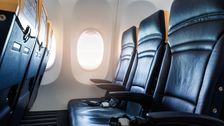
For many people, air travel often involves a seat belt that doesn’t fit. Some travelers find they need to get a seat belt extender: a piece that goes between the belt and the buckle to help the two connect. TikTokers such as Remi Bader, Nikki Garza and Adelia Lauren have shared their experiences with these items, and the term “seat belt extender on airplane” has millions of views on the platform.
While some flyers have had good experiences and know there’s nothing wrong with needing an extender, others have understandably felt angry at how ridiculously size-exclusive the standard seat belt length is. Let’s be real: Seat belt extenders shouldn’t have to exist, especially since so many of us need them. As a required safety measure, the regular belts should be long enough to fit everyone.
But in case you find yourself needing a seat belt extender, here’s some information to make the process as easy and stress-free as possible.
How and when to request a seat belt extender
According to 2020 data published by TripSavvy, an expert-based travel site, each airline has different lengths of seat belts and extenders. The exact length of seat belts varies by airline and by reports, ranging anywhere from 31 inches to around 51 inches.
Calling the airline is likely your best bet for getting an exact answer. This can feel like a difficult task ― especially the first time (more on how to navigate that in a second). Some airlines may make you reserve an extender in advance, so it’s best to check options before your flight.
If you don’t have to reserve ahead, asking early is best. That’s according to Pam Luk, the founder of Ember & Ace, a plus-size athletic wear brand. “I like to ask for the extender as soon as I board while everyone is still stowing their carry-on and getting settled,” said Luk, who’s had to use an extender since her early 40s. “That way, I don’t feel like all eyes and ears are on me and my request.”
Wendy Dragon, a fat, Health at Every Size-aligned clinical psychologist engaged in research and activism about individuals in larger bodies, recommended not giving into avoidance (waiting to ask, getting a friend to ask, that kind of thing). She suggested asking directly. “Just ask for the extender, and don’t feel the need to explain why it is needed,” she said.
If it makes you more comfortable, you can also buy seat belt extenders. However, using the ones provided is probably the way to go, since some airlines may not allow you to bring your own. It’s important to check compliance rules before purchasing or packing anything.
If you feel uncomfortable or triggered for even having to ask, that’s valid
We live in a fatphobic culture where people discriminate and hold prejudice against people in larger bodies. “So much in this culture is tied up with body size,” Dragon said, noting how we’re perceived by romantic partners, medical providers, family and even employers.
If thinking about all of this is stressful, that’s understandable. “It may look like an innocuous piece of metal and webbing to some, but asking for it can trigger feelings experienced during past trauma and bullying around weight,” Dragon said.
“For a person who already experiences discrimination and marginalization for their body size, not fitting into a seat belt can feel like confirmation that their body is somehow wrong, bad and unworthy, and has no value,” said Katie Piel, a therapist who works with clients of all sizes on their eating disorders and body image distress. “While bean counters look for ways to maximize profit on airplanes by making seat spaces narrower … the physical comfort of the consumer does not appear to enter the equation.”
Ivan Sviatkovskyi / EyeEm via Getty Images
How to take care of difficult emotions that arise
Flight attendants should be (and usually are) kind and discreet when getting a seat belt extender for you. If you encounter someone who isn’t, Luk shared some recommendations for getting through the process. “Take a few deep breaths to feel a bit more calm and centered,” she said. “Consider reciting a mantra to yourself, like ‘I deserve to be safe and comfortable.’”
Being gentle with yourself is crucial. “Pregame your brain with some self-compassion and positive self-talk,” Piel said. “It’s the plane’s job to fit you, not the other way around. Instead of focusing on your body, turn your mind to your trip.”
Dragon noted that “we often say things to ourselves we would never say to anyone else.” She recommended telling ourselves what we would tell a loved one who felt overwhelmed.
Once you’re fully settled, distract yourself. Piel suggested reading or downloading a podcast or some other form of entertainment to enjoy.
Talking to a therapist before or after the trip can also be a great idea. Body image is a tough struggle, especially when systemic fatphobia is in the picture, and professional help is often needed.
If you haven’t found a therapist yet (or don’t like your current one), Dragon recommended finding ones who not only identify as HAES-aligned, but have material on their website to back it up.
“See if larger people are included in the pictures,” she said. “Look if they have testimonials, if weight loss is mentioned. Reach out to the Association for Size Diversity and Health — they have a list of providers that have taken the HAES pledge.”
Dragon also recommended getting support from loved ones and other people who live in larger bodies. Reddit, Facebook and Instagram are great places to find people who’ve dealt with similar experiences.
Ultimately, every person deserves safety and respect, Piel emphasized. Flying should be an inclusive experience ― period.
Source link
CHECK OUT: Top Travel Destinations
READ MORE: Travel News



